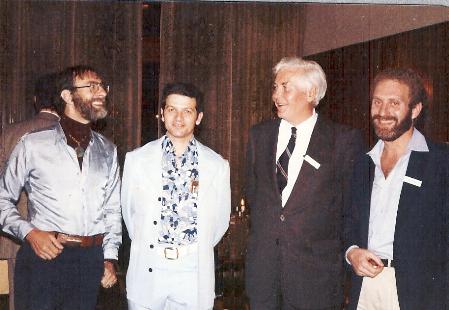Stories
Disappointed to learn that Yale no longer had the interdisciplinary studies of IHR, I needed to find another way to take advantage of its graduate school in psychology. I made a list of all of the professors associated with the psychology department and went to their laboratories, one by one, looking for one in which I would like to work.
That's how I came on the laboratory of John Flynn. I arrived as one of his graduate students, David Egger, was stimulating the brain of a cat. As long as he kept his hand on the stimulation button, the cat would pursue and eventually kill the rat in its cage, but the moment that he let up on the button, the cat looked around as if surprised, and stopped hunting the rat. This could be repeated time and again. It was a remarkable demonstration of controlling the brain. Fascinated, I asked if I could work in that lab.
At first I worked with David Egger who, like me, had been a winner of the National Science Talent Search. I helped him remove the cerebral cortex from kittens, so tiny their eyes weren't even open yet. For anesthesia, we put them on a block of ice. Some died but many survived and grew up without a cerebral cortex. David kept them in a room with normal cats and dared the professors to tell the difference between them without looking for the surgical scars on their heads. They couldn't tell the difference. I don't think the results were even published, but it shows how little we know about the brain!
Over the next few years, working in Flynn's lab, I came to know many talented graduate students, medical students and post-docs, attracted by John Flynn.
John had been a priest in his youth, so talented that we went to the Vatican to translate ancient texts into modern church Latin. But his professor dared to criticize the Pope, so he was defrocked and so were all his students. Disillusioned, John returned to America, and worked as the assistant to the great psychologist Robert Woodworth at Columbia University. Woodworth's textbooks, Elements of Physiological Psychology in 1911 and Experimental Psychology, 1938 and 1954, were classics. Woodworth had been a student collaborator with Sherrington on their famous 1904 paper, "A pseudoaffective reflex and its spinal path".
Bringing the history to a full circle, John hired at one point Sherrington's assistant who knew how to handle animals. It was he who taught me how to capture and hold cats no matter how frightened and vicious they might be. Sherrington given his great Silliman lectures at Yale in 1904 with the most beautiful, poetic description of the nervous system I have ever seen.
In April 2005, his daughter Sarah donated his most prized possession, the three-volume set of Ramon y Cajal’s Textura del Sistema Nervioso del Hombra y de los Vetebratos, in the original Spanish (Madrid, 1889–1904) to the Yale Medical Historical Library. Inside the first volume is an inscription written by Cajal himself in 1910, which reads in translation, "Because of the brain, man is the king of creation, and to clarify the structure of the brain is to understand why that figure is at the head of the animal kingdom and how civilization was created, a sign of human superiority to the rest of the beings. My original idea was that I would not be able to take a sure step in the study of physiology and pathology of the nervous system without knowing the cerebral machine with precision, and that the mysteries of the science of the spirit will only be clarified when all the unknowns relative to the chemistry of the fine structures of the nerve cell are cleared up. This book represents only a humble advance toward this ideal, which will be discerned in the science of the future.”
At Columbia University, John had met and married a young communist named Hulda, and although he himself was rather conservative politically, he would be politically attacked his entire life by his association with his wife, to the point that universities offered him jobs if he would divorce her. As his daughter Sarah has said, "Thank goodness he didn't, or I might not have been born!".
When I came long, John Flynn was carefully studying and putting into practice the combination of ethological and neurophysiological methods. Although he never spoke very much to me about my dissertation, in which I recorded from individual neurons during fighting behavior (a tour de force!), I was very much inspired by his approach.
 |
| John Flynn, second from right, at a symposium in his honor in Haren, Netherlands, 1980, along with his students, left to right, myself, Allan Siegel and Dick Bandler. |
In 1980 some of his graduates, including me, held a symposium in his honor at the meetings of the International Society for Research on Aggression in Holland. I had asked him if we couldn't write a joint paper for that meeting, but he didn't want to. He died, not long after the symposium, some of us say, from a broken heart from which he had never recovered after the tragic death of the oldest of his three beautiful daughters who set herself on fire in protest against the war in Vietnam.
 |
Stages
1986-1992
Fall of Soviet Empire
1992-1997
UNESCO Culture of Peace Programme
1997-2001
UN Intl Year for Culture of Peace